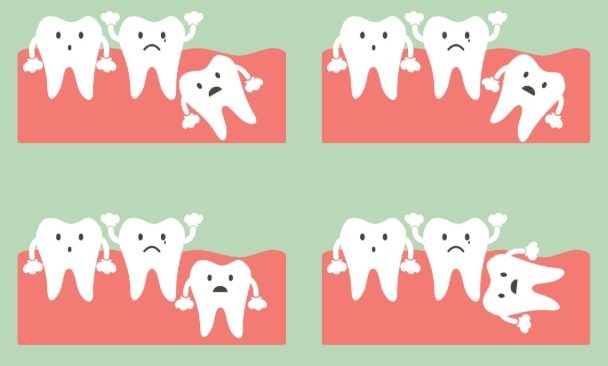Wisdom teeth impaction is one of the most common reasons for wisdom teeth extraction. Impaction occurs when there is not enough room for the tooth to erupt, making it grow partially or fully underneath the gums and sometimes causing excruciating pain. There are different types of wisdom teeth impactions. Impacted wisdom teeth always come with some sort of pain because they are pushing against adjacent teeth. While almost any sort of impaction requires surgery, some types of impaction do not necessarily require that your wisdom teeth get extracted.
The following are some of the most common types of impacted wisdom teeth.
– Horizontal Wisdom Tooth Impaction
Considered the worst and most painful type of impaction, horizontal impaction occurs when the wisdom tooth lies horizontally and parallel to the jawbone, causing friction on the adjacent tooth. In this type of impaction, the tooth is completely immersed inside the gum tissue and doesn’t erupt to the surface. Extraction is usually complicated and requires professional precision and artistry of a specialized dentist or oral surgeon.
– Vertical Impacted Wisdom Teeth
A vertically impacted wisdom tooth erupts pretty much the normal way and in alignment with the adjacent teeth. However, complications can occur if the tooth causes friction against the adjacent tooth root or the underlying bones at the back of the jaw, and this might warrant an extraction. Vertically impacted wisdom teeth don’t normally require extraction if they don’t affect the other teeth or the jaw bone. While vertical impactions don’t necessarily require extraction, this type of impaction can sometimes cause other complications such as teeth misalignment and crowding. If your dentist examines the potential of your wisdom teeth eruption causing crowding, he may advise you to consider extraction. If you would like a proper examination to determine whether your wisdom teeth need to be extracted or not, visit our dentist in Melbourne to get the best diagnosis.
– Angled impaction
This is the most common type of impaction. Angular impacted wisdom teeth have the type of impaction whereby the tooth angled on either direction of the mouth. There are two variations of angular impaction, depending on which direction the teeth are facing.
1. Mesial Impaction
Mesial impaction is the type of angled impaction whereby the tooth erupts facing the other teeth towards the front of the mouth, causing friction on the adjacent teeth, usually accompanied by pain.
2. Distal Impaction
The other variation of angular impaction is the distal impaction. Distal impaction is the opposite of mesial impaction because the tooth faces the opposite direction of the other teeth. This means that the tooth erupts towards the back of the mouth with the roots pushing against the roots of the adjacent tooth. Most angular impactions erupt partially to the surface called partially erupted wisdom tooth, making extraction easier.
Bottom Line
If you think you might have an impacted wisdom tooth or are experiencing an impacted wisdom tooth pain, you might want to consider visiting our dentist in Melbourne to help make a proper diagnosis on the type of impaction you might have. This diagnosis will help to determine whether your teeth need an emergency wisdom tooth removal or not.

